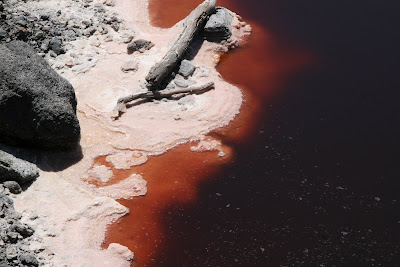 In this third episode of “Discovering Kenya”, we decided to go to Lake Magadi.
In this third episode of “Discovering Kenya”, we decided to go to Lake Magadi. Deep in the heart of Southern Kenya’s Maasai land is the unearthly Lake Magadi. This 104 sq km soda lake is completely surrounded by vast natural salt flats. Rarely visited by tourists because it is located in a remote area at the Kenyan south border with Tanzania, Magadi area is known for being one of the hottest and driest place of Kenya and for its pinkish mirror-like soda lake.
Albert (<While leaving Nairobi covered in clouds and approximately 20 degrees, we anticipated that Lake Magadi would be nice and cool as well. A classic tourist mistake, packed with a sweater and long trousers, we headed for our new destination. Soon, the descent into the Rift Valley already revealed that the temperatures and weather in the Nairobi highlands are completely different than the Rift Valley plains. Every minute of the three hour drive, temperatures rose and more sun shine down on our car.
This trip we made with Guy and Sietske, two of our friends in Kenya. Good to know that Guy is a part-time rally driver and we literally flew over the roads to the lake. All roads are quite good, and they are working to improve the middle section. Leaving at 11am from our home, we had our lunch around 2 pm on the other side of the lake.
Lake Magadi is fully owned by Magadi Soda, a soda producing firm. Owning the entire lake guarantees that no competition will be present at the lake, also making sure that around 95% of all salt in Kenya is coming from Magadi Soda. A surrealistic scenery can be witnessed at the lake. A pinkish shore (due to the salt), salt plains and smelly water is what Lake Magadi characterizes. Whenever you see the lake, you also see the huge factory on its shores, steaming and making soda. Trains are transporting it back to Nairobi and Mombasa, where it will be sold. A small town is located next to the factory, housing the 300 people working at the factory. Really a communistic feeling when driving around, small flats for the workers, large houses for management and semi-attached houses for middle management. Road signs show clearly who is living in each house, in case anyone forgets.
We were heading to a specific camp, called Lale'enok Resource Centre. This is fairly new community based conservancy (Olkiramatian Group Ranch) on the south side of the lake. Reason for going here is that Sietske is likely to take her students on a field trip to this conservancy, so we voluntarily acted as Guiney pigs for the camp site and activities offered. The campsite is really nice, lots of shade and the facilities are all brand new. There is even a separate kitchen place (not equipped), separate toilets and showers. As we understand this campsite (and research centre) is on the water pipeline to Magadi, so although water remains relatively scares in these areas, it was not an issue when we were around.
To get the facts straight: there are two community conservancies in the area, one on Olkiramatian Group Ranch (where we camped) and one on the neighboring Shompole Group Ranch. The campsite does not strictly belong to the Olkiramatian Group Ranch, but a conservation fee will be charged when you drive around (on game drives for instance). Shompole conservance is further down the road (coming from Magadi) and charges a fee as well. We did not visit this conservancy so this story sticks to Lake Magadi only.
The total trip to the campsite is approximately 170 kilometres from Nairobi, that includes a nice picknickspot on the way
While Sietske was not feeling well, we limited the number of activities during this weekend. In the afternoon, we made camp and relaxed. In the evening made a fire, played with the dogs and made some dinner. We went to bed quite early because we were going to do the “Walk with Baboons” the next morning at 6am.
This is the key selling point for this camp: to go walking with a local, habituated baboon troop. This is a really amazing experience and you can be taken by Joel <
The next morning, the three of us joined Joel on his walk. Joel has an amazing knowledge about nature in general, no matter if it are plants, trees or animals. We found ‘his’ group of baboons after a 45 minute walk. The group consists of 55 members (individuals) and Joel knows them by heart. Unfortunately, the animals were avoiding our group (3 of us and 2 guides) and we couldn’t get really close to the group. Joel’s information on how the baboons live, what they do, eat and drink and his fascination on nature made our early morning walk more than worth the short night sleep. Eventually we were back at the camp at 9.45am, hungry for breakfast.
Sietske was still not feeling well, so after breakfast we headed home. On the way back, we stopped at a [njama choma] place called [Olopole], about an hours drive from Nairobi. This place is famous for its meat and the views on the Rift Valley. Really a good spot to have lunch J
After our lunch (4pm) we headed back to town. From Nairobi really a good two-day trip. We did not see any other tourist, only local Masai, animals and nature. The weekend re-fueled our batteries with sun, ready for a new week in the ‘cold’ (20 degrees) Nairobi.
Simon & Evelien



















